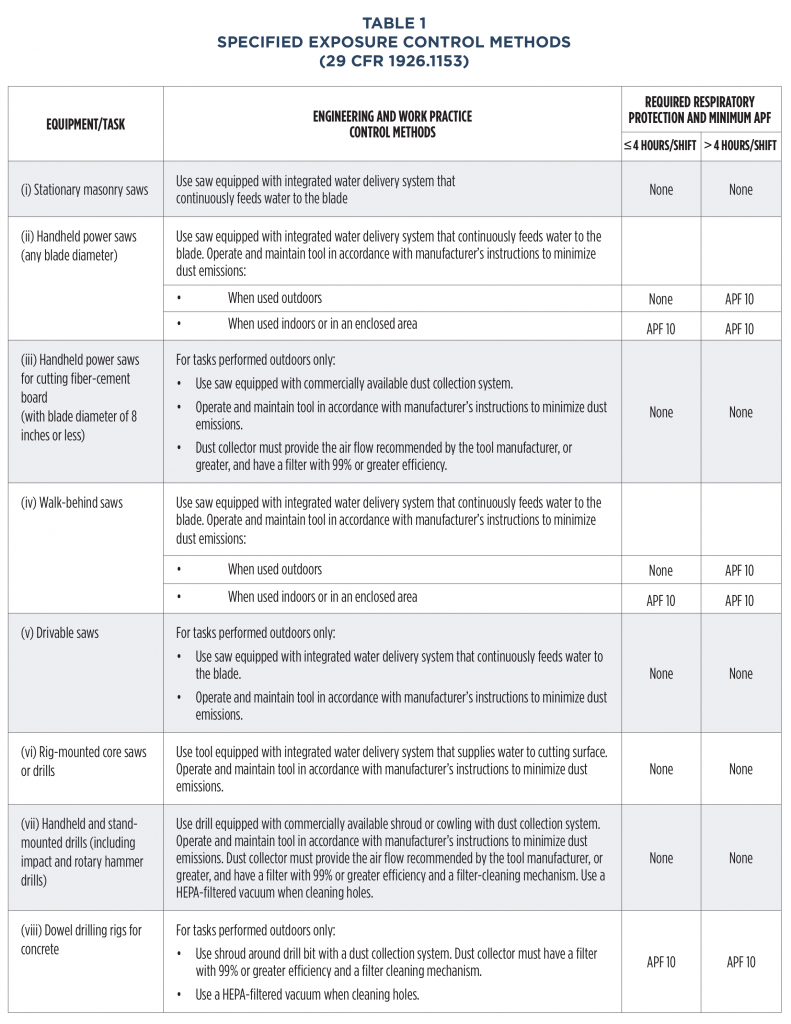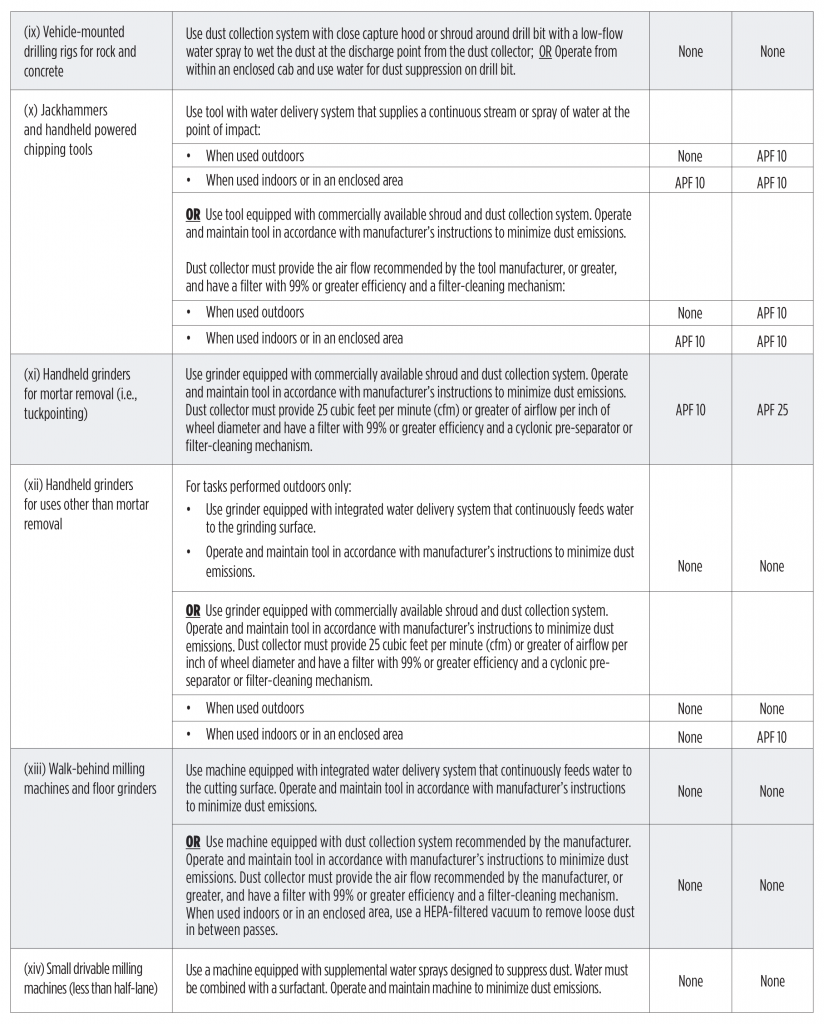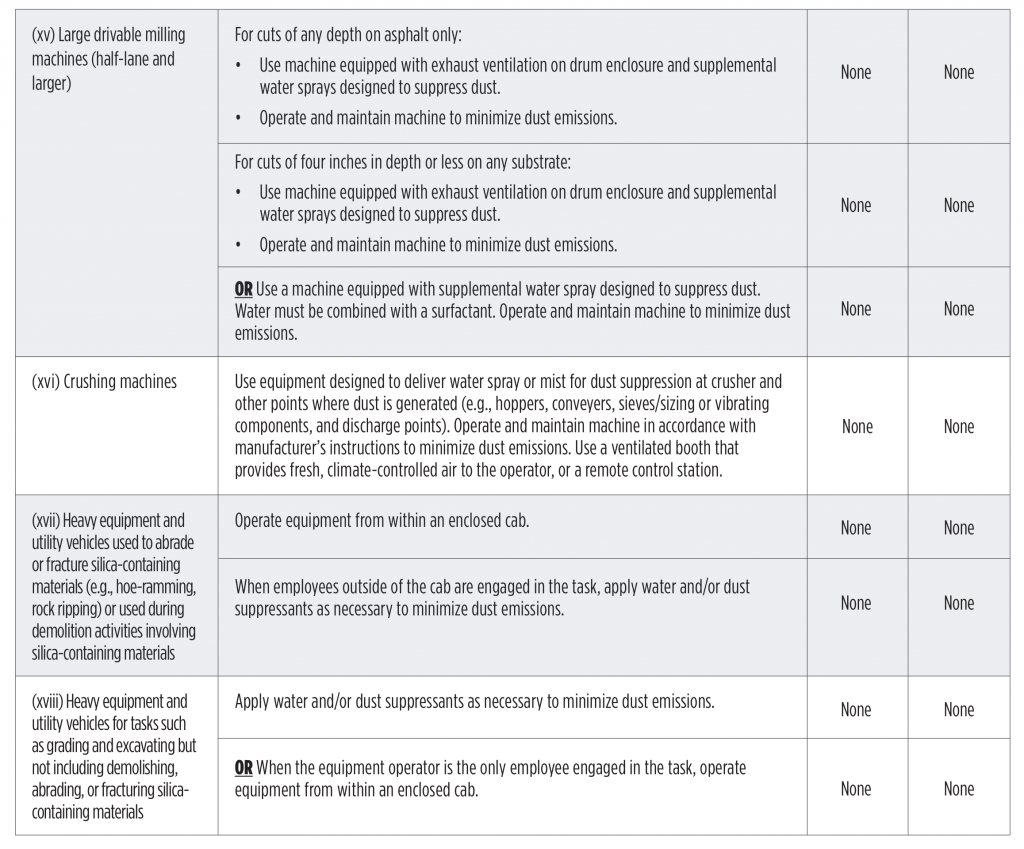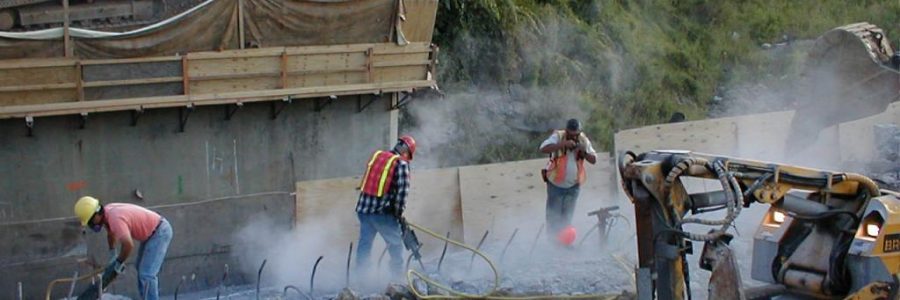
OSHA’S RULE FOR RESPIRABLE CRYSTALLINE SILICA
BY JEROME SPEAR, CSP, CIH * J.E. SPEAR CONSULTING, LP
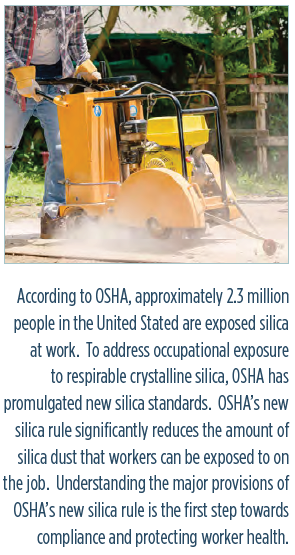 Silica dust is hazardous when very small (respirable) particles are inhaled. These respirable dust particles can penetrate deep into the lungs and cause disabling and sometimes fatal lung diseases, including silicosis and lung cancer, as well as kidney disease. From 2005 through 2014, silicosis was listed as the underlying or a contributing cause of death on over 1,100 death certificates in the United States (CDS, 2016), but most deaths from silicosis go undiagnosed and unreported. Also, the numbers of silicosis deaths do not include additional deaths from other silica-related diseases such as Chronic Obstructive Pulmonary Disease (COPD), lung-cancer, and kidney disease. While the number of silicosis cases has declined over the past several decades, more workers died from silicosis in 2014 than in fires or being caught in or crushed by collapsing materials, such as in trench and structure collapses (BLS, 2014).
Silica dust is hazardous when very small (respirable) particles are inhaled. These respirable dust particles can penetrate deep into the lungs and cause disabling and sometimes fatal lung diseases, including silicosis and lung cancer, as well as kidney disease. From 2005 through 2014, silicosis was listed as the underlying or a contributing cause of death on over 1,100 death certificates in the United States (CDS, 2016), but most deaths from silicosis go undiagnosed and unreported. Also, the numbers of silicosis deaths do not include additional deaths from other silica-related diseases such as Chronic Obstructive Pulmonary Disease (COPD), lung-cancer, and kidney disease. While the number of silicosis cases has declined over the past several decades, more workers died from silicosis in 2014 than in fires or being caught in or crushed by collapsing materials, such as in trench and structure collapses (BLS, 2014).
WHAT IS SILICA?
Silica is a compound composed of the elements silicon and oxygen (SiO2) and exists in crystalline and amorphous states, both in the natural environment and as produced during manufacturing or other processes. Quartz is the most common form of crystalline silica and accounts for almost 12% (by volume) of the earth’s crust. It accounts for the overwhelming majority of naturally found silica and is present in varying amounts in almost every type of mineral; thus, quartz is the most prevalent form of crystalline silica found in the workplace. Cristobalite and tridymite are relatively rare forms of crystalline silica; both are associated with volcanic activity. Cristobalite can be created during some processes conducted in the workplace; whereas, tridymite requires the presence of a flux such as sodium oxide and is rarely reported in the workplace.
Quartz converts to cristobalite at 1470 °C. At 1723 °C, cristobalite loses its crystalline structure and becomes amorphous fused silica. Amorphous silica includes vitreous and fused silica, quartz glass, biogenic silica, and opals, which are amorphous silica hydrates. OSHA’s silica standard applies to exposure to respirable crystalline silica, not amorphous silica.
INDUSTRY USES
There are over 30 major industries and operations where exposures to crystalline silica can occur. They include diverse workplaces such as foundries, dental laboratories, concrete products, and paint and coating manufacturing, as well as construction activities including masonry cutting, drilling, grinding, tuckpointing, and use of heavy equipment during demolition activities involving silica-containing materials. Exposures to crystalline silica dust occur in common workplace operations involving the following types of operations:
- Earth drilling (and operations involving the disturbance of the earth’s crust)
- Cutting, sawing, drilling, and crushing of concrete, brick, rock, and stone
products (such as construction tasks) - Operations using sand products (such as in glass manufacturing, foundries,
sand blasting, and hydraulic fracturing)
Sand and gravel are used in road building and concrete construction. Sand with greater than 98% silica is used in the manufacture of glass and ceramics. Silica sand is used to form molds for metal castings in foundries, and in abrasive blasting operations. Silica is also used as a filler in plastics, rubber, and paint, and as an abrasive in soaps and scouring cleansers. Silica sand is used to filter impurities from municipal water and sewage treatment plants, and in hydraulic fracturing for oil and gas recovery. Silica sand is also used to manufacture artificial stone products used as bathroom and kitchen counter tops, and the silica content in those products can exceed 85 percent.
Crystalline silica exposures can also occur in mining (which is under the jurisdiction of MSHA) and in agriculture during plowing and harvesting.
MAJOR PROVISIONS OF OSHA’S SILICA RULE
OSHA promulgated two separate standards that addresses occupational exposure to respirable crystalline silica – one for exposures in general industry and maritime (29 CFR 1910.1053) and another for exposures in the construction industry (29 CFR 1926.1153). The two standards are similar with some differences to account for the different work activities, anticipated exposures, and other conditions. The major provisions of OSHA’s silica rule (and the differences between the two standards) are summarized below.
Scope and Application: The OSHA silica rule apply to all exposures to respirable crystalline silica except for the following:
- Agricultural operations
- Exposures that result from the process of sorptive clays
- Objective data demonstrates exposures will remain below 25 micrograms
per cubic meter (μg/m3 ) as an 8-hour time-weighted average (TWA) under
foreseeable conditions.
Permissible Exposure Limit (PEL): 50 μg/m3
Action Level (AL): 25 μg/m3
Exposure Assessment: Any combination of exposure monitoring data or objective data may be used to accurately characterize exposures to crystalline silica. A reassessment of exposures is required whenever there has been a change in the production process, control equipment, personnel, or work practices that may reasonably be expected to result in new or additional exposures to respirable crystalline silica at or above the Action Level.
At construction worksites, the employer is not required to assess the exposures of employees engaged in the tasks or take additional measures to ensure that exposures do not exceed the PEL where the employer has fully and properly implemented the engineering controls, work practices, and respiratory protection as prescribed for the specified tasks in Table 1.
Exposure Monitoring: If the scheduled exposure monitoring option is used to assess exposure, monitoring must be performed:
- Initially
- Every 3 months if ≥ PEL
- Every 6 months if ≥ AL
- Discontinue if < AL (and subsequent exposure monitoring taken at least 7 days
later confirms exposure < AL)
Employee Notification: Results of the exposure assessment must be posted (or each affected employee must be notified in writing) within:
- 15 working days after completing an exposure assessment (general industry/
maritime) - 5 working days after completing an exposure assessment (construction)
The employee notification must describe the corrective action being taken to reduce employee exposure to or below the PEL.

Written Exposure Control Plan: A written exposure control plan is required and must contain at least the following elements:
- Description of the tasks that involve exposure to respirable silica;
- Description of the engineering controls, work practices, and respiratory protection used to limit employee exposure to respirable crystalline silica for each task; and
- Description of the housekeeping measures used to limit employee exposure to
respirable crystalline silica. - For construction worksites, a description of procedures used to restrict access to work areas, when necessary, must also be included to minimize the number of employees exposed to respirable crystalline silica and their level of exposure, including exposures generated by other employers.
The written exposure control plan must be readily available for examination and copying, upon request, to each employee and OSHA.
The written exposure control plan must be evaluated at least annually and update as necessary.
Competent Person: A competent person must be designated for construction worksites who has the responsibility to implement the written exposure control plan. A competent person as defined by OSHA, is:
“An individual who is capable of identifying existing and foreseeable respirable crystalline silica hazards in the workplace and who has authorization to take prompt corrective measures to eliminate or minimize them.”
The competent person requirement applies to construction worksites. The standard for general industry and maritime does not have provisions for designated a competent person.
Regulated Areas: Regulated areas must be demarcated when reasonably expected to be in excess of the PEL. DANGER signs must be posted at all entrances to regulated areas.
This provision applies to general industry/maritime worksites but does not apply to construction work sites. However, the silica standard for construction requires that the exposure control plan include procedures to restrict access to work areas to minimize the number of employees exposed to respirable crystalline silica.
Methods of Compliance: Feasible engineering controls must be implemented to reduce exposures to or below the PEL. When it is infeasible to reduce exposures to or below the PEL, the employer must reduce exposures to the lowest achievable levels and supplement such engineering and work practice controls with respiratory protection.
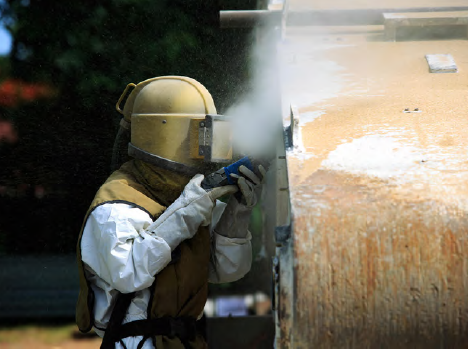 Specified Exposure Control Methods: The construction standard specifies 18 tasks and prescribes the engineering controls, work practices, and respiratory protection for each task (see Table 1).
Specified Exposure Control Methods: The construction standard specifies 18 tasks and prescribes the engineering controls, work practices, and respiratory protection for each task (see Table 1).
The employer is not required to perform an exposure assessment and/or limit exposures when engaged in these specified tasks providing that the employer has fully and properly implemented the engineering controls, work practices, and respiratory protection as specified for these tasks in the construction standard.
OSHA permits employers of general industry/maritime to follow the construction standard rather than the general industry/maritime standard when the task(s) specified in the construction standard are indistinguishable from the task(s) performed at the general industry/maritime worksite(s). This option is permitted by general industry/maritime employers only when the tasks are not performed regularly in the same environment and conditions (e.g., maintenance and repair tasks).
For tasks not specified in the construction standard or where the employer has not fully and properly implemented the engineering controls, work practices, and respiratory protection prescribed for such tasks, the exposures are required to be assessed and feasible engineering controls must be implemented to reduce exposures below the PEL.
Housekeeping: Dry sweeping or dry brushing is not allowed unless wet sweeping, HEPA-filtered vacuuming, or other methods that minimize the likelihood of exposure are not feasible. Compressed air shall not be used to clean clothing or surfaces where such activity could contribute to exposure to respirable crystalline silica unless effective local exhaust ventilation is used or there is no feasible alternative method.
Medical Surveillance: For general industry/maritime worksites, medical surveillance exams shall be made available to employees who will be occupationally exposed to respirable crystalline silica at or above the Action Level for 30 or more days per year. For construction worksites, medical surveillance exams shall be made available to employees who are required to use a respirator for 30 or more days a year.
When medical surveillance exams are required, the initial exam must be made available within 30 days after initial assignment. Periodic medical examinations are required at least every three years, or more frequently if recommended by the physician or other licensed healthcare professional (PLHCP).
Hazard Communication: Employees must have access to labels on containers of crystalline silica and safety data sheets, and receive training in at least the following silica hazards: cancer, lung effects, immune system effects, and kidney effects.
Recordkeeping: The following documents must be maintained:
- Exposure monitoring data
- Objective data
- Medical surveillance records
COMPLIANCE DATES
OSHA’s silica rule became effective on June 23, 2016 but employers are given time to comply with the new standards. Employer obligations for construction were given one year to comply with the standard, establishing an effective compliance date of June 23, 2017 except for the laboratory analysis provisions of the standard, which has a compliance date of June 23, 2018.
The compliance date for general industry and maritime is June 23, 2018. Some additional delays for the compliance dates are provided for complying with the medical surveillance requirements and implementing feasible engineering controls for hydraulic fracturing operations in the oil and gas industry.
The effective dates for complying with the medical surveillance provisions of the standard for general industry/ maritime is June 23, 2018 if exposed at or above the PEL for 30 or more days per year and June 23, 2020 (if exposed at or above the action level for 30 or more days per year). The effective date for complying with the provisions for implementing feasible engineering controls for hydraulic fracturing operations is June 23, 2021.
OSHA estimates that the new silica standards will save the lives of more than 600 workers each year and prevent more than 900 cases of silicosis each year once the full effects of the rule are realized.
Print Friendly Version of Osha’s Rule For Respirable Crystalline Silica

